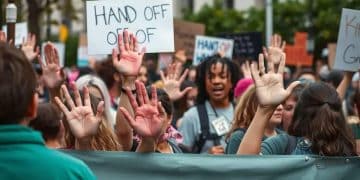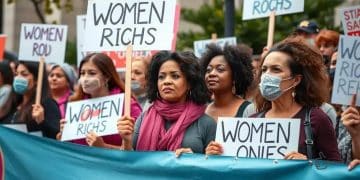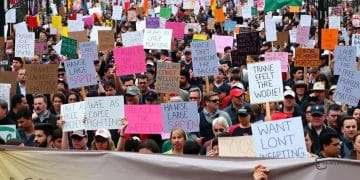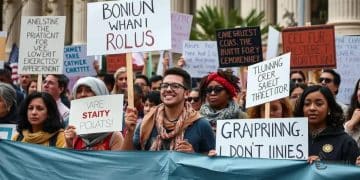Participation of labor unions in protest activities
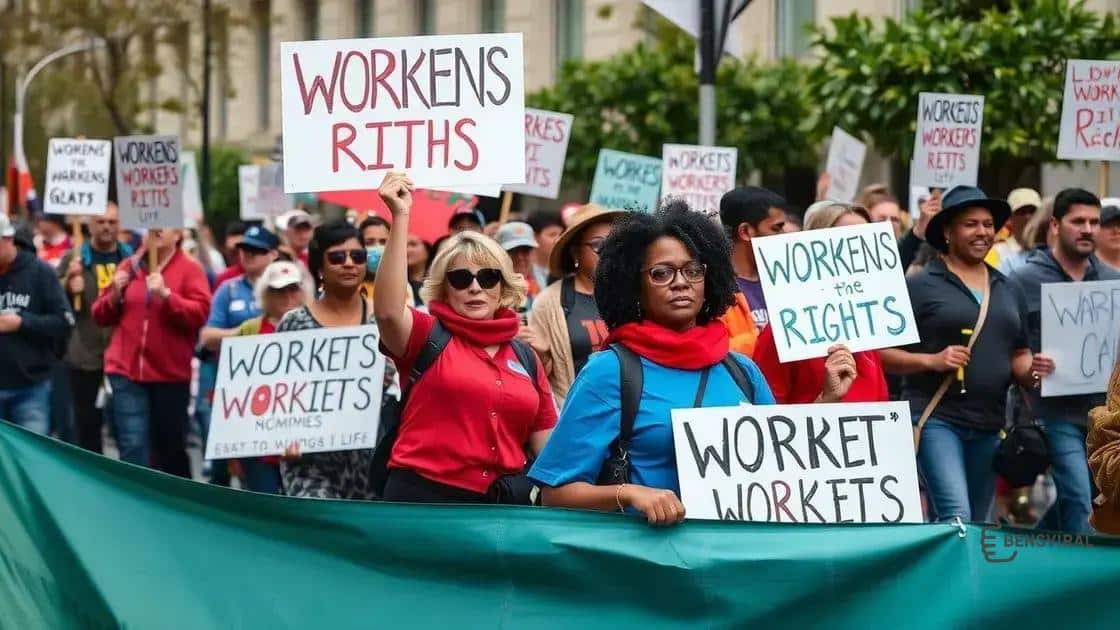
The participation of labor unions in protest activities is vital for advocating workers’ rights, as they leverage technology and social media to mobilize, raise awareness, and build coalitions for social change.
Participation of labor unions in protest activities plays a crucial role in advocating for workers’ rights. Have you ever wondered how these unions shape social justice movements? Let’s dive deeper into their impact.
Historical background of labor unions in protests
The historical background of labor unions in protests is essential to understanding their current role in advocating for workers’ rights. Labor unions emerged in the early 19th century as a response to the harsh conditions faced by workers. Over time, they became powerful entities, organizing protests to demand better wages, safer working conditions, and fair treatment.
The origins of labor unions
Labor unions began as informal groups among workers forming to address grievances. These early unions struggled for recognition and legal protection. The shift occurred during the Industrial Revolution, which highlighted the need for organized labor. Workers united to amplify their voices, leading to significant protests aimed at asserting their rights.
Key milestones in labor protests
- The establishment of the Eight-Hour Workday Movement in the 1880s.
- The infamous Haymarket Riot of 1886, which brought attention to labor demands.
- The formation of major unions like the American Federation of Labor in 1886.
- Continuous protests during the Great Depression for better pay and job security.
As labor unions grew, so did their impact on legislation. Protests became more organized and strategic, often influencing government policies. The success found in these protests can be attributed to the growing solidarity among workers. This unity fostered a sense of community and purpose, empowering individuals to stand up against injustices.
Modern labor protests
Today, labor unions continue to engage in protests that address contemporary issues. Issues like income inequality, job security, and workers’ rights are at the forefront. The methods of protesting have evolved, incorporating technology and social media to mobilize supporters more effectively.
Key achievements through protest participation
Key achievements through protest participation have significantly shaped the labor movement. Over the decades, labor unions have engaged in countless protests, leading to vital victories for workers’ rights. These achievements not only improved conditions for employees but also established foundational rights that many enjoy today.
Major milestones
One of the most impactful achievements was the establishment of the minimum wage in the United States. Through persistent protests, unions highlighted the struggles of low-paid workers, pushing for legal changes. This movement was crucial in providing a baseline for fair compensation.
Legislation changes
- The Fair Labor Standards Act of 1938, which set standards for minimum wage.
- The Occupational Safety and Health Act of 1970, ensuring safer workplaces.
- The Family and Medical Leave Act of 1993, providing job protection for medical leaves.
- Recent battles for higher wages, often leading to strikes for $15/hour minimum wage initiatives.
Additionally, protests have been essential in raising awareness about worker exploitation and unfair labor practices. By uniting workers, unions have successfully pressured companies and governments to adopt better labor laws. This collective effort has drawn public attention to necessary reforms and ensured that workers have a platform to voice their concerns.
Social impact
The social impact of these protests cannot be understated. They not only secured tangible outcomes for workers but also cultivated a sense of community among laborers. This community spirit further inspired subsequent generations to advocate for their rights. Through ongoing efforts and participation in protests, labor unions have strengthened the foundation of workers’ rights in various industries.
The role of social media in modern labor protests
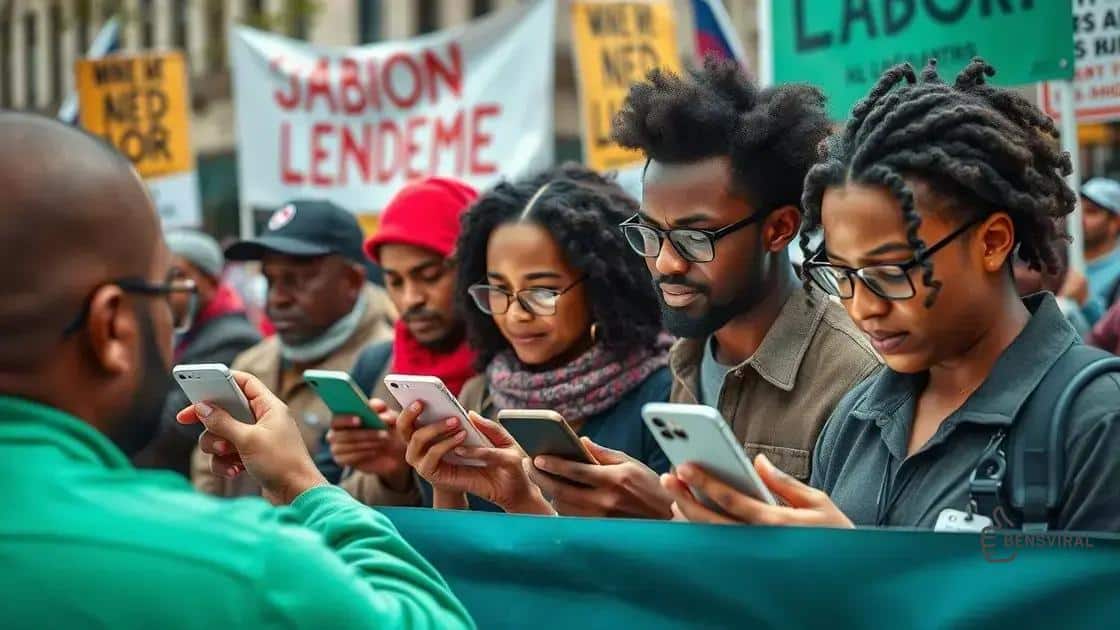
The role of social media in modern labor protests has transformed how unions organize and mobilize. In today’s digital age, social media platforms provide powerful tools for communication and engagement. Workers can share their experiences and connect with others instantly, amplifying their collective voice.
Mobilization and organization
Social media enables rapid mobilization of workers for protests and strikes. Organizers can use platforms like Twitter, Facebook, and Instagram to share details about upcoming events. This immediacy allows union leaders to gather supporters quickly and efficiently. Additionally, hashtags can unify messages, making it easier for participants to find relevant information.
Awareness and advocacy
- Spreading awareness about workers’ rights and current issues.
- Encouraging public support for labor movements.
- Highlighting injustices faced by workers in real-time.
- Creating viral campaigns that attract media attention.
With social media, workers can document protests and share their stories with a broader audience. This visibility can garner public sympathy and pressure companies to change their practices. Videos and images from protests can go viral, bringing new supporters to the cause. This kind of exposure is vital for attracting attention to labor issues that might otherwise be overlooked.
Building community
Furthermore, social media fosters a sense of community among workers. It allows individuals to connect across geographical boundaries, sharing strategies and solidarity. This sense of shared purpose can be empowering, as workers realize they are part of a larger movement. Engaging with others online can inspire individuals to participate actively in local unions and protests.
Challenges faced by labor unions during protests
Labor unions face various challenges during protests, which can impact their effectiveness and goals. Understanding these challenges helps in recognizing the complexities of labor movements and the resilience of union efforts. Protests can be powerful, but they come with obstacles that unions must navigate carefully.
Legal and regulatory barriers
One major challenge is dealing with legal restrictions. Many areas have laws that limit how unions can protest. These laws may include permits required for gatherings or restrictions on the times and places where protests can occur. Unions must often spend time and resources to ensure compliance with these regulations, which can delay their efforts.
Public perception
- Negative media coverage can sway public opinion against unions.
- Misunderstandings about union goals may create resistance.
- Conflicts with local businesses can strain community relations.
- Protests may lead to backlash from certain political groups.
Public perception also poses challenges. If the community sees protests as disruptive, support for the union may dwindle. This lack of support can make it difficult for unions to achieve their goals. To counteract this, unions need to engage with the public and inform them about the reasons behind their actions.
Internal divisions
Internal divisions within unions can complicate protest efforts. Different factions may have varying priorities, leading to disagreements on strategies or goals. These divisions can weaken solidarity among workers, reducing the overall impact of protests. Unions must work to maintain unity and ensure that all voices are heard in the decision-making process.
Future of labor unions in protest activities
The future of labor unions in protest activities is evolving as challenges and opportunities arise. In an increasingly digital world, unions are adapting their strategies to remain relevant and effective. This evolution is crucial for advocating workers’ rights in dynamic labor markets.
Adapting to technology
Technology is shaping how unions organize and mobilize. Social media platforms are becoming essential tools for reaching out to members and the public. Union leaders can quickly disseminate information, rally support, and organize protests more effectively. This adaptability helps unions engage younger workers who prioritize online communication.
Raising awareness
- Utilizing online platforms to spread knowledge about labor issues.
- Creating campaigns that resonate with diverse audiences.
- Collaborating with other social movements to amplify voices.
- Highlighting global labor rights issues to gain broader support.
Moreover, unions are focusing on raising awareness about current labor issues and important social justice movements. By collaborating with other social movements, unions can strengthen their message and mobilize more people. There is a significant opportunity for unions to unite workers with shared goals, creating a more powerful collective voice.
Strengthening coalitions
Looking ahead, strengthening coalitions will likely play a critical role in the future of labor unions. By forming alliances with community organizations, environmental groups, and other stakeholders, unions can broaden their influence. These coalitions can help address not only workplace issues but also social and economic disparities affecting workers.
FAQ – Frequently Asked Questions about Labor Unions and Protests
What challenges do labor unions face during protests?
Labor unions often face legal barriers, public perception issues, and internal divisions that can hinder their effectiveness during protests.
How has technology changed protest activities for unions?
Technology, especially social media, has changed how unions organize and mobilize, allowing for quicker communication and broader outreach.
What is the importance of raising awareness in labor protests?
Raising awareness helps to garner public support, highlight labor issues, and strengthen the union’s message and impact.
How can unions strengthen their influence in the future?
Unions can strengthen their influence by building coalitions with other organizations, leveraging technology, and maintaining unity among members.

